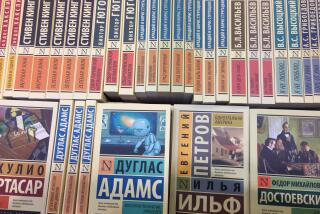NONFICTION - Nov. 24, 1985
- Share via
A TIME FOR PEACE by Mikhail S. Gorbachev (Richardson & Steirman: $15.95). There are more teachers of English in the Soviet Union than there are students of Russian in the United States. Americans must rely on translations, therefore, for their knowledge of even the most unsecret, matter-of-course Soviet views. And such translations have been far from abundant. “Pravda” is only now being published in an English edition. Soviet books in English translation have long been available through Imported Publications, Inc., in Chicago, but few books from this publisher ever receive much notice.
“A Time for Peace,” a collection of speeches and other messages delivered by the Soviet general secretary both abroad--to heads of state and journalists--and at home, will receive more notice and deserves a large audience. The collection begins with a brief introduction, written for the occasion by Mikhail Gorbachev himself. There follows a capsule biography--more accurately, a capsule hagiography--and a photo-insert, including a few family snapshots. Then come the speeches.
Many of the them--particularly the briefer ones--are utterly bland and ceremonial: “Dear Mongolian friends, we are meeting in a momentous period,” etc.
A few of the speeches are major addresses, however, and reveal official Soviet thinking in ways that Americans may find eye-opening.
“The Immortal Exploits of the Soviet People,” a 10-page speech delivered on the anniversary of the end of World War II, presents the official Soviet version of that war. The Western powers encouraged Nazism by the Munich Pact and in other ways, ignoring the warnings of the Soviet Union, treating its denunciations of Hitler as just “communist propaganda.” Late in the day, they did join the Soviet Union in its epochal fight against Nazism, but the opening of the “second front” was helpful--no more.
As for the continuing, peaceful struggle between the communist and capitalist systems, Gorbachev writes in “Creative Effort of the People,” another exceptionally long speech: “It is not we, but capitalism which has to maneuver and put on masks, resort to wars and terror, falsification and sabotage, in order to hold back the implacable onslaught of time . . . Capitalism has no future. And it is no accident that social development as depicted by capitalist ideologists has come to a dead end and is frozen, as it were. Herein lies not only ideological and theoretical impotence, but also a grave practical danger. A system which has no future fails to value either the past or the present. Here lies the root cause of adventurist imperialist policy.”
“Creative Effort of the People” includes a relatively detailed account of the relationship between American borrowing and lending on the one hand and world economic instability on the other. Its contentions are debatable, to say the very least of them, but they do reveal why Gorbachev may be as formidable in debate as he is said to be.
The collection as a whole is atrociously edited: Veitnamese for Vietnamese , comerative for commemorative , party for parity , Malcolm Baldbridge (in display type at a chapter opening) for Malcolm Baldridge , and even Gerbachev for Gorbachev , to name just a few among innumerable examples. The publisher may perhaps be excused for rushing the book into print; but if there is to be a second printing, then let there be a first proofreading.
More to Read
Sign up for our Book Club newsletter
Get the latest news, events and more from the Los Angeles Times Book Club, and help us get L.A. reading and talking.
You may occasionally receive promotional content from the Los Angeles Times.










